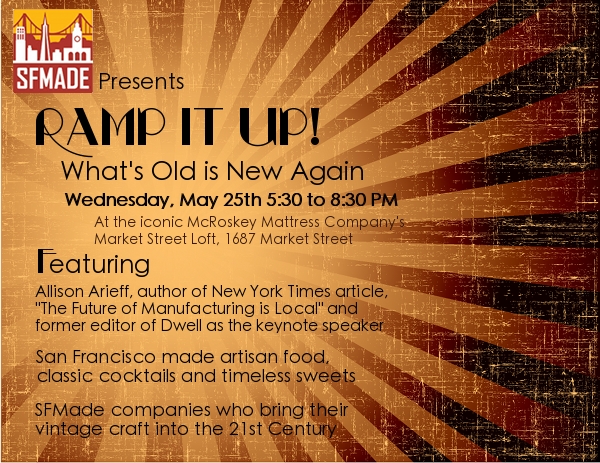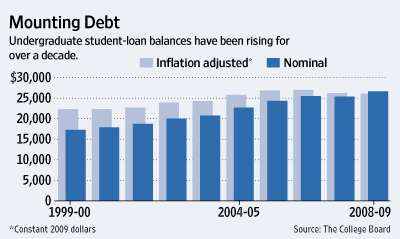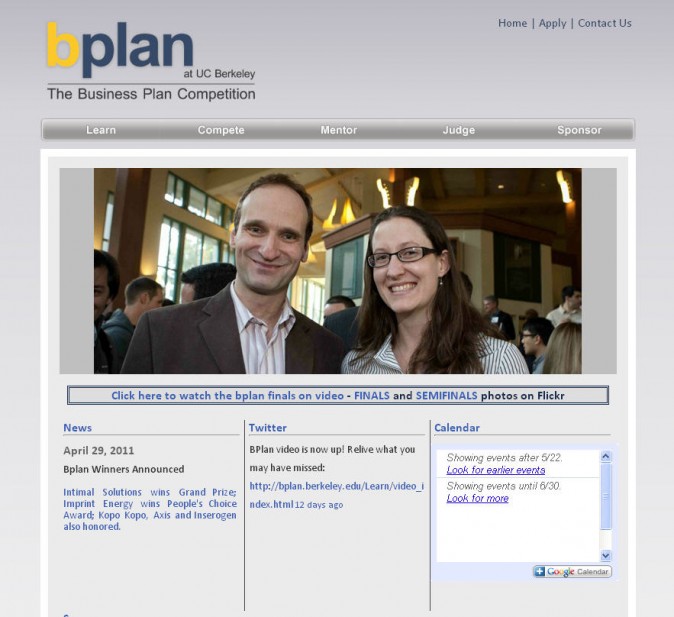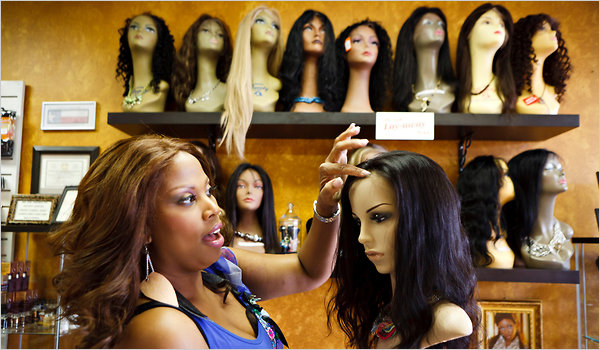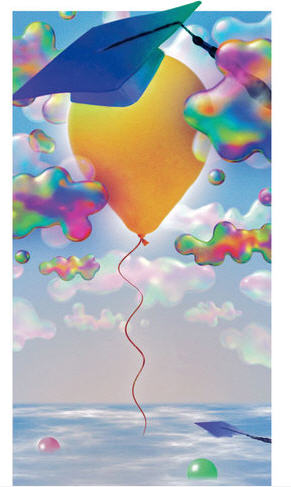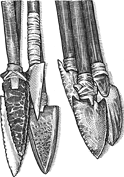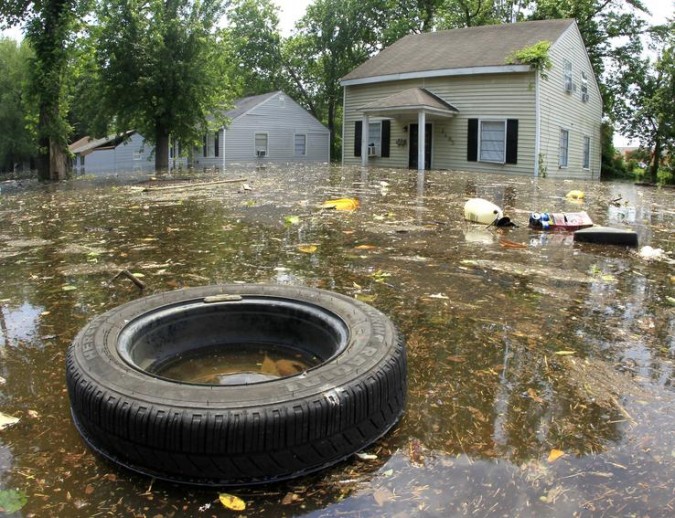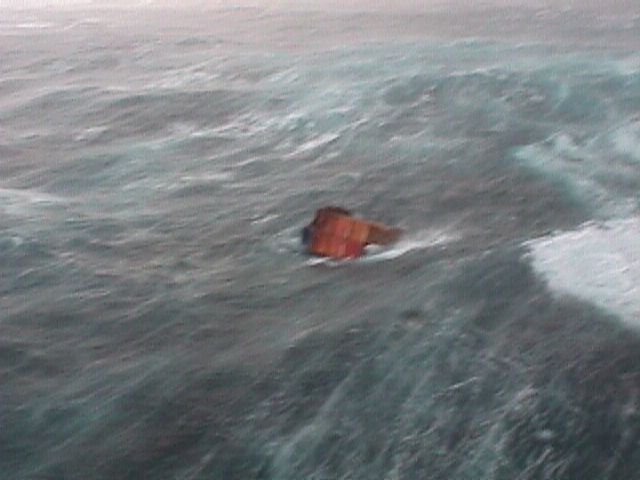Archive for May, 2011
I met the founder of Dark Garden at SFMade’s Ramp It Up event
I met Autumn Adamme this evening at Ramp It Up, a fundraiser by SFMade.
I first wrote about SFMade in February, 2011.
Adamme is the founder of Dark Garden, a San Francisco manufacturer of fine women’s corsets. Adamme operates a retail store at 321 Linden Street, and I believe all her products are made at the store.
I found Adamme to be inspiring. She moved away from home at age 16 and started Dark Garden in her garage when she was only 18 years old, in 1989. She has operated this business continuously her entire adult life. I can’t think of any other entrepreneur that started so young and stayed with their original venture for as long. Adamme looks to be about 30 years old, so she hasn’t let the daily grind of running a successful business beat her down.
Dark Garden is a lovely store. I was there a couple of times helping a woman select and buy a corset. The staff is very pleasant and passionate about what they’re doing. The location is down a small street, and the decor is funky, warm and sexy – I found it a perfect environment for what they sell. I’ve been to many high end lingerie stores, and while Dark Garden isn’t selling lingerie, I found the vibe at the Dark Garden store the most appealing, personal and real of all.
I’m writing abut Dark Garden because I am considering leaving the Internet entrepreneurship world and getting into manufacturing. This is a big and somewhat scary move for me. I love hearing stories like those Adamme shared with me this evening, and I wanted to let her know that she made an impression on my thinking.
I’m attending Ramp It Up, a fundraiser by SFMade.org
I’m considering manufacturing self contained green homes in San Francisco, California. I don’t know much about the manufacturing business, and I have few contacts in the industry. To help fix that, I’m going to the first SFMade annual fund raiser tonight.
SFMade is a new trade organization that formed to promote the interests of companies that manufacture physical goods in San Francisco.
I first wrote about SFMade on Feburary 28, 2011.
Here’s the link to the event page for this SFMade event, titled Ramp It Up.
The ticket price is USD $45.00, of which USD $25.00 is tax deductible under US tax laws.
I built my first aquaponics system – you’ll never guess where it is
I’ve written about my friend Kevin Casey a few times before (January 7, 2011, January 9, 2011 and January 11, 2011). I met him in 2007 when he was one of the student organizers for the University of California Berkeley Business Plan Competition. I was a judge and financial sponsor for that competition, so we had plenty of opportunities to talk. We became friends on Facebook, and when he started posting status updates about his startup New Avenue, Inc., I got back in touch with him.
Kevin staged the ribbon cutting for his first house on January 8th, 2011. Soon after, the city of San Jose, California contacted Kevin and asked that he construct a custom house for a 9 month exhibit of green technologies called the San Jose Green Vision Clean Energy Showcase. This exhibit opened this month, in May, 2011. The location is directly across the street from the sparkling City Hall of San Jose.
Here’s the PDF brochure that San Jose is distributing about its Clean Energy Showcase.
Ever since I contacted Kevin in late 2010, I have been talking his ear off about my ideas for shipping container based green housing. One of the parts to my grand plans is to make it practical for residents to grow food at home. The most exciting and productive way to grow food in limited space with limited water is to raise fish and vegetables in symbiotic harmony. This technique is widely known by the word ‘aquaponics.’
Kevin approached me and asked if I’d like to set up a small demonstration aquaponics system on the front porch of his New Avenue demo green home. I jumped at the chance, as this gives me a great excuse to learn more about this and help a friend at the same time. Aquaponics is really popular in Australia, which is in the midst of an 11 year draught. Aquaponics systems use 1/10th the water required to grow vegetables in dirt. Since the world is ‘running out’ of fresh water, it makes sense to learn more about a system that makes such efficient use of water.
I put together a system with off the shelf parts I selected and modified personally. The result doesn’t look bad, but doesn’t look like a commercial polished product either. I am happy with the result for my first system. I used a wire shelf rack from Costco as the frame. I was concerned that infants could drown in a system that didn’t fully cover the water tank, so by setting the height of the first shelf to just over the height of the water tank, I eliminated that risk. You can see this safety feature in the picture above.
The water aerator and the timer are located in an exterior grade water resistant steel junction box fastened to the rear shelf. From there, the system is connected to a GFCI outdoor outlet on the rear of the house. While you can’t see it in the picture because I hadn’t installed it yet, the fish are fed automatically each day via a timed automatic fish feeder.
The vegetable bed is flooded with a foot of water from the fish tank 24 times a day. The flood/drain cycle takes about 18 minutes, and starts on the top of each hour. The pump consumes just 18 watts during a 15 minute per hour fill cycle. The extra 3 minutes is the time it takes for the growing bed to drain back into the fish tank.
The vegetable roots cleanse the water. Since the vegetables get all the water they can absorb, they grow faster than in dirt, up to 600% faster. The fish also grow faster than normal because they get so much clean and well aerated water. It’s a true win/win scenario. The main inputs are fish food and water to replace what is lost to transpiration and evaporation. On occasion, there are tiny inputs of a teaspoon or so of fluid to adjust the pH to keep everything happy. I understand that this is needed primarily during the first 6 weeks of operation, before the healthy bacteria have established themselves in the clay beads that the plants grow in.
I am no expert, but I’m learning a lot, and I appreciate the opportunity to learn on such a public stage. I’ve already met two people that have seen my system and want one of their own!
To learn more, read Backyard Aquaponics Magazine.
Special thanks to Sylvia Berstein, Founder and CEO of The Aquaponic Source, who helped me set up my first system and sold me some of the key parts. Her store is located in Boulder, Colorado, USA.
Money lessons for everyone
I read Money Lessons for Every High-School Graduate by Zac Bissonnette in today’s Wall Street Journal newspaper. Bissonnette’s piece is one of the most direct and sensible articles about money I’ve yet read.
While the lessons of this article are aimed at recent high school graduates, I think the lessons have yet to be learned by many people.
Lesson number four particularly resonates with me:
“Materialism is misery: Lives of thrift and conscientiousness lead to less stress, greater enjoyment of the things we do have and a lighter carbon footprint. But most of our societal associations with wealth are deeply connected with materialism: luxury goods, power and status.
“The more materialistic values are at the center of our lives, the more our quality of life is diminished,” says Knox College psychologist Tim Kasser, author of “The High Price of Materialism.”
Recognize the real benefits of wealth — freedom and flexibility — and don’t let the pursuit of its illusory trappings interfere with your ability to reap those rewards.”
Thanks to my generous relatives, rental and investment income, I have the freedom and flexibility the passage refers to.
That makes me richer than almost everyone I know, in my mind.
Even better, I am happy. I like my house, car and possessions, and I rarely dream of upgrading them.
Might I appreciate a gilded existence? Perhaps, but perhaps not, because with material riches come pressures that I have seen make many people unhappy.
I’ll take my happy, freedom filled middle class life over an unhappy, constrained upper class life… with joy.
I am confident I’ll make a lot more money, but happiness is more important than money.
4. Materialism is misery: Lives of thrift and conscientiousness lead to less stress, greater enjoyment of the things we do have and a lighter carbon footprint. But most of our societal associations with wealth are deeply connected with materialism: luxury goods, power and status.
“The more materialistic values are at the center of our lives, the more our quality of life is diminished,” says Knox College psychologist Tim Kasser, author of “The High Price of Materialism.”
Recognize the real benefits of wealth — freedom and flexibility — and don’t let the pursuit of its illusory trappings interfere with your ability to reap those rewards.
I’m on the front page of the Berkeley Business Plan Competition website
Here’s something I never expected:
My picture is on the front page of the Berkeley Business Plan Competition website.
I’m pictured with AutoTB Co-Founder and CEO Kelly Karns. AutoTB won the competition in 2009. This picture was taken by long time Berkeley event photographer Bruce Cook at the public finals awards ceremony on April 28, 2011.
I’m a judge and sponsor for the Berkeley Business Plan Competition, and I was a contestant in 1999.
Stealing hair for money
Here’s an article entitled ‘Costly Hairstyle Is a Beauty Trend That Draws Thieves’ Notice’ about the crime of stealing human hair. I had no idea thieves stole hair on an epic scale until I read this article. The salon owner pictured below had $150,000 worth of hair stolen from her business during one such theft. Thankfully, the thieves are not taking the hair directly from its source.
Is college is too easy?
The opinion piece published May 14, 2011 in The New York Times newspaper entitled Your So-Called Education makes a good case that university and college students are being cheated by their schools.
I have several friends that graduate this month from University of California, Berkeley. I hope they see this blog post and can comment publicly or privately whether they agree with the authors.
I certainly feel that the classes at University of California at Los Angeles, where I went, were too easy. The only classes I recall that really challenged me were Astrophysics and Computer Programming. The Astrophysics class was an AP level course, and I really had to work hard. But I remember a lot from that class today. The Computer Programming class was not an AP level class, but it was also really hard work. That class was the single most important class of my life, as it laid the groundwork for me to become a programmer.
All the other classes were forgettable and not challenging.
I’m nearly certain I learned to write in high school, not at university. The classes at Laboratory School, where I went to high school in Chicago, were harder than most of the classes I took at UCLA.
When I was at Brooks Institute, after UCLA, the classes were a joke. I could and usually did pass them with only one day a week of work. I regret I didn’t instead attend Art Center, in Passadena, CA, which reportedly required that an assignment be turned in 5 days a week. This would have been painful at the time, but beneficial to me in the long run.
If you are thinking about enrolling at Brooks, save your money. It was a full fledged economic scam. Yes, I learned to take pretty good pictures, but that was because of my talent for it that I developed after graduation. They could have compressed their ‘4 year program’ into six months of actual hard work and saved my parents a fortune. A Brooks Institute degree used to cost about what a Stanford University degree used to cost. I should have gone to Stanford. I’m certain I could have kept up with and done the work, given what I know of my Stanford graduate friends. In fact, I have a strong and powerful suspicion that even most of the classes at Stanford aren’t particularly challenging.
Comments?
Back to the stone age
Here’s an off the beaten path article I love the Wall Street Journal newspaper for writing:
Armed With Stone-Tipped Arrows, Hunters Stalk Their Inner Cave Men
According the the article, there are a subset of hunters that are ditching their guns and carbon fiber bows, in favor of bows and stone tipped arrows they make personally.
Here’s a passage from the piece:
“Interest in the stone-age lifestyle has been growing. In recent years, archaeology buffs started arrowhead-making groups in places like Portland, Ore., and Pasadena, Calif. Other die-hards have adopted meat-heavy “paleo” diets, eating like traditional hunter-gatherers.
While there has long been a cult of hunters who use old-style rifles and bows, “bowhunting has picked up pretty tremendously across the country,” says Mike Moore, chief executive of Primitive Archer magazine. The publication’s circulation is up 25% over the past five years, to roughly 30,000, he says.”
I don’t think Bus Conversions Magazine, which covers my hobby of converting a bus to a motorhome, has 30,000 subscribers. I am impressed that so many people are into ‘primitive archery.’ I see it as related to urban homesteading — getting back to nature and how things used to be done.
Flood resistant homes built from ocean shipping containers
The more I dream about becoming a builder of green homes, the more ideas I come up with.
Today’s crazy idea was inspired by the dramatic 2011 Mississippi River floods now happening.
As I’ve disclosed here before, I want to base my green homes, at least to start, on recycled ocean shipping containers. These containers are strong, waterproof and standardized across the planet. Many companies and private individuals already make homes from shipping containers. I have many spins on the concepts that I think make my plans stand out from other plans I’ve seen.
Unaltered containers are pretty water tight. They are so water tight that when they fall off a container ship during a storm, they float for a while — even months is possible. They are a major hazard for other boats and ships, because they are very hard to spot, as they float so that most of the container is submerged, with only about a foot sticking up out of the water. If a boat hits a floating container, that boat can sink from the damage caused by the impact.
My uncle Gerald Warnock is an avid fisherman. On our most recent fishing expedition, last month, I was telling him about my green housing ideas, and he said floating containers are such a marine hazard that there are plans being discussed to install a ‘fuse’ in the side of containers that will disintegrate when immersed in water. Thus, an overboard container will flood and sink once the fuse disintegrates. This will send the cargo to the bottom, but make water travel safer.
I think it would be better to put a satellite beacon in every container, and have the beacon activate when the container is imersed in water. Then the container location could be broadcast on the Internet, and treasure seekers could go pick up the container. Perhaps there could be a bounty sharing treaty set up so the entity salvaging the container would get to keep half of the value and the original owner would get the other half.
People on land spend hours with metal detectors looking for valuables on beaches and elsewhere. I bet that overnight a mini industry would spring up if there were an electronic map overlay website with dots where floating lost shipping containers potentially filled with valuable new products could be found. In fact, I predict that salvagers would compete and the team with the fastest ship would prevail. I don’t know how ships get public data at sea, but there must be a way to publish container location GPS coordinates via a low cost system that can be accessed while at sea. Since the containers are on the move, one would need up to the minute satellite beacon information to justify spending fuel money to travel to a location where a container is supposed to be. I advocate publishing the contents and declared value of the container’s contents along with the coordinates, so salvagers will be able to gauge whether it’s worth it to make the trip. Environmental groups should like my plan, as sunken containers probably aren’t a good thing.
That’s not my idea I intended to write up in this post… it’s just another one of my ideas I’ve wanted to write up for a while now.
My idea I intended to write in this post is to use the shipping container door as the home door, leaving the weather stripping intact. Yes, I would dress up the door and insulate it, to increase its asthetic appeal. But if I leave the original door, then the home can stay watertight if I make the other openings similarly watertight.
Thus, the windows would have to have shutters that could be closed, and the shutters would need to be water tight like the door. The roof hatch also would need to be water tight, and any openings for plumbing lines, electrical lines and the like also would need to be watertight.
Such watertight products already exist for the maritime industry. The roof hatch on a sailboat is reasonably watertight, and while these cost more than a house skylight, they’re not that much more costly. I doubt a sailboat hatch could withstand water pressure if the container were many feet underwater. So, to combat that threat, I could use a submarine hatch! That should handle whatever pressure develops… Seriously though, I doubt flooded areas encounter flood depths such that marine grade trap doors and hatches would not keep most or all of the water out.
The resident of a green home built as I describe here could weather a flood by just closing the door, the windows and the roof hatch. Even if the home were entirely underwater, it would remain dry inside. I wouldn’t recommend trying to live inside, as the air would run out in short order, of course. But when news of an impending flood is received, it would take just minutes to close up the house and depart for higher ground.
There will be tremendous societal benefit to avoiding the billions of dollars in flood damage that results from our current non-waterproof housing.
Shipping container homes without waterproof doors, windows and roof hatches are already very resistant to earthquakes and tornados. Adding waterproofing is not really much extra work, and I would consider making it standard for all homes in flood prone areas, and an available option for all homes, since flooding is likely to get worse over the next few centuries, and I predict any green homes I make from shipping containers will endure for at least a century. These would not be throwaway mobile homes with a cheap feel from day one. These would be rock solid, nearly indestructible homes to pass down from generation to generation.
When I was touring NIMBY a while back to look for space to build a container home, I saw shipping containers from decades ago, from before their design was standardized by the ISO. These things don’t fall apart. I think a properly designed container home clad in suitable exterior siding like brick or granite could last indefinitely — certainly as long as the centuries old housing one sees in parts of Amsterdam and Paris.
EFactor – The largest network for entrepreneurs

I had never heard of EFactor until recently. It’s the largest [social] network for entrepreneurs in the world, according to the EFactor website.
I learned about EFactor from one of its cofounders, Marion Freijsen.
We were both final round judges for the Made for China Entrepreneurial Pitch Competition presented by Berkeley Chinese Students and Scholars Association. This event took place April 27, 2011 at International House in Berkeley, California. EFactor wrote a nice story about the pitch competition.
Freijsen invited me to see their extremely cool office at the cable car turnaround on Market Street in San Francisco, California. You can see Freijsen in the picture above. She’s the first person in the upper left. I’m the third person in the top row, from the left.
The EFactor office is in the Flood Building, a grand and important 100+ year old office building in San Francisco. What makes their office cool though is that it’s circular, as it’s in the front round part of the building you see when you’re standing at the cable car turntable and look up. I have seen this facade hundreds of times, but never before have I been inside one of those round offices.
Sadly, I’m still mostly unfamiliar with EFactor, as I devoted too much of my time with Freijsen talking her ears off about my plans to improve the human condition with my efficient housing, energy, food and finance ideas. Next time I see her, I’ll insist she do all the talking.

